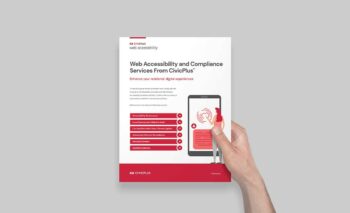How to Get Buy-In for Purchasing a New Website Accessibility Tool
When it comes to website design, accessibility is not just an ethical and legal obligation — it’s a smart business move. By creating an accessible website with a website accessibility tool, you can connect with a broader audience, enhance user experience, and position your organization as a socially responsible leader in your sector.
Investing in a new solution to monitor and improve website accessibility is a crucial step toward ensuring compliance with accessibility guidelines, such as the Web Content Accessibility Guidelines (WCAG). But getting everyone in your organization on board may require some persuasive finesse.
Keep reading for key facts and strategies to help you make a compelling case for purchasing a new tool to keep your website compliant and accessible to all.
Step-by-Step Guide to Gaining Stakeholder Buy-In
Step 1: Educate and Engage Early
Start by educating stakeholders about the importance of website accessibility. Share essential information about relevant laws and regulations, such as the Web Content Accessibility Guidelines (WCAG). Explain the potential consequences of non-compliance, including legal risks and reputational damage.
Use relatable, real-world examples to illustrate how accessibility impacts users and the organization. Share stories about how accessible websites positively influence user experience and foster inclusivity.
Pro Tip: Host an internal workshop or presentation to introduce accessibility concepts and demonstrate real cases where accessibility tools made a difference.
The Complete ADA Compliance Checklist for 2025
Step 2: Involve Stakeholders from the Start
Involve key stakeholders in the conversation early. Identify who needs to be on board — including leadership, IT, marketing, and compliance teams — and seek their input. Encourage open discussions to understand their perspectives and address any concerns they may have.
Pro Tip: Create a cross-functional task force to evaluate the tool options together. This builds a sense of ownership and reduces resistance.
Building ADA-Compliant Municipal Websites: Best Practices for Meeting Accessibility Guidelines
Step 3: Provide Evidence and Data
Demonstrating the current state of your website’s accessibility is crucial. Conduct an accessibility audit and present the findings. Show data on compliance gaps and potential risks, and compare your website’s performance against industry benchmarks. Highlight any instances where a lack of accessibility has led to user complaints or reputational issues.
Pro Tip: Use visuals like charts and graphs to make the data more digestible. Quantifying potential gains, like improved user satisfaction, will strengthen your case.
Supplement with a Website Scan
Step 4: Build a Business Case with ROI
Clearly outline the expected return on investment (ROI). Explain how investing in a website accessibility tool can save time and money by proactively identifying and addressing issues. Mention the long-term benefits, such as increased audience reach, improved engagement, and reduced risk of legal challenges.
Break down costs versus benefits, including projected savings from avoiding legal fees and the positive impact on public perception.
Pro Tip: Highlight successful case studies from other organizations that adopted similar tools and achieved measurable results.
Additional CivicPlus Case Studies
4 Reasons to Invest in a Website Accessibility Tool
Committing to accessibility shows your agency’s dedication to inclusivity and social responsibility, boosting your reputation. Investing in a website accessibility tool demonstrates your commitment to online equity and sends a positive message to residents, staff, and stakeholders.
But that’s not all—investing in such a tool also allows your agency to:
- Maintain Compliance: Ensure your website meets legal standards to avoid costly lawsuits and fines.
- Boost Engagement: Reach a broader audience by making your content accessible to everyone.
- Save Resources: Automate issue detection and remediation, saving time and reducing manual effort.
- Lead in Inclusivity: Position your organization as a socially responsible leader.
Conclusion
Gaining stakeholder buy-in for website accessibility tools requires strategic communication, data-backed evidence, and a clear demonstration of ROI. By involving key players early and presenting a comprehensive, benefits-focused case, you’ll increase your chances of success.
Consider CivicPlus Web Accessibility, the industry leader, as your top choice for ensuring compliance and enhancing user engagement.
For more insights, download the Local Government Website Accessibility Checklist and ensure your agency’s digital presence is inclusive and compliant.


